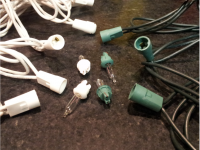Back in January I posted the blog, which discussed the two competing standards for EV charging ports. This is the “Beta vs VHS” debate in the EV world that will determine compatibility between vehicles and charging stations. In just the short time since I originally wrote that blog, there has been a fair amount of activity.
There are two basic levels available today for charging EVs today. The first is the SAE J1772 standard which provides for “Level 1” or “Level 2” charging. This essentially refers to 120V AC household current (Level 1) and 240V AC (Level 2, household or otherwise), which provides at-home, overnight charging or “opportunity” charging at public stations. The second is DC fast charging, which allows vehicles to be fully recharged in less than an hour, and where this debate centers.
The two competing styles are the CHAdeMO and SAE J1772 “Combo:”


The competing standards are being pushed by both auto manufacturers as well as companies that are rolling out the public charging infrastructure (charging stations). Japanese automakers Nissan, Toyota, and Mitsubishi have been using the CHAdeMO standard for several years now, on a variety of cars. In North America, only the Nissan LEAF and Mitsubishi i-MiEV are equipped with this port currently. Even with only two vehicles sold with this port today, it still has the lions share of the current market- since the SAE “Combo” standard is still not being sold anywhere. With respect to available charging stations, more than 150 CHAdeMO stations are in use today, provided by Blink, Aerovironment, EATON, and other existing suppliers of stations and charging equipment. This is by far the dominant standard.
The SAE “Combo” standard is an up-and-comer, though. While not currently sold on any vehicles or available at any charging stations today, manufacturers such as GM, Ford, BMW, and Volkswagen have announced that they will be supporting this standard in 2014 and later models. Additionally, Car Charging Group, one of the largest charging networks suppliers in North America, has announced that are endorsing the standard. While this is just one of many suppliers, it is one, and it is first. More are likely to follow.
To further muddy the issue, perhaps the most visible EV company, Tesla, has decided not to support either standard (not directly, at least). Their “Supercharger” stations, which provide for DC fast charging, use a proprietary setup. They have, however, announced that they will be providing an adapter to allow their vehicles to use the SAE “Combo” standard. Consider this at least a tip-of-the-hat towards the SAE standard.
This is far from over and I am sure will continue to evolve rapidly. If new vehicles like the 2014 Chevy Spark EV, which uses the SAE “Combo” standard, take off, it could be a game changer. Much like the Betamax vs VHS debate, it will only take one or a handful of early adopters to cause one standard to take off and the other to languish.



